light Seat Ibiza ST 2012 Workshop Manual
[x] Cancel search | Manufacturer: SEAT, Model Year: 2012, Model line: Ibiza ST, Model: Seat Ibiza ST 2012Pages: 282, PDF Size: 3.77 MB
Page 121 of 282
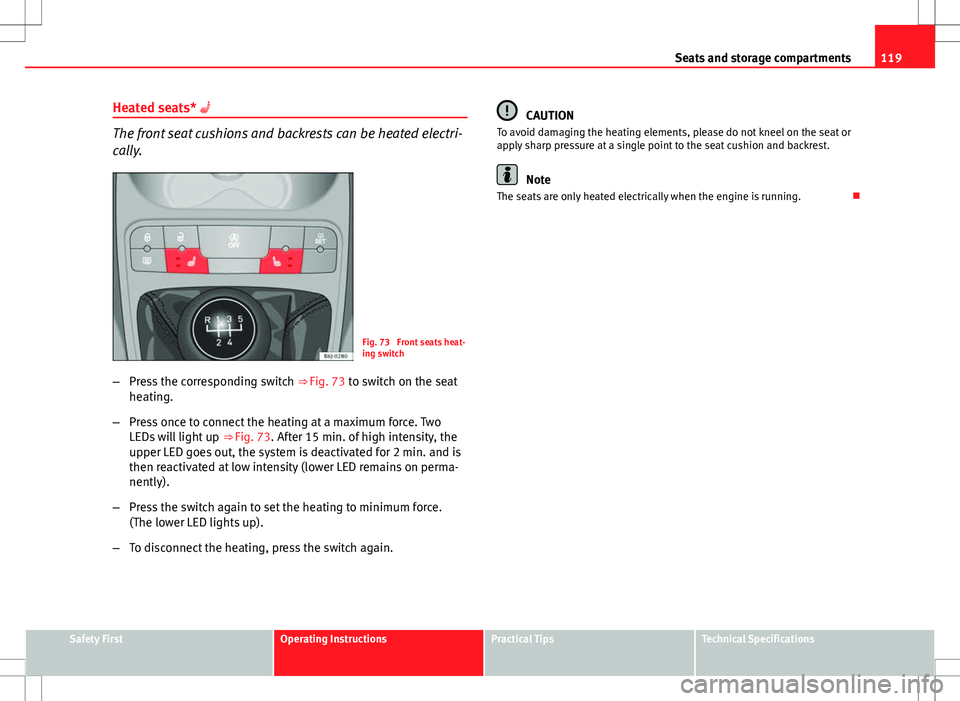
119
Seats and storage compartments
Heated seats* ο‘
The front seat cushions and backrests can be heated electri-
cally.
Fig. 73 Front seats heat-
ing switch
β Press the corresponding switch ββFig. 73 to switch on the seat
heating.
β Press once to connect the heating at a maximum force. Two
LEDs will light up ββFig. 73. After 15 min. of high intensity, the
upper LED goes out, the system is deactivated for 2 min. and is
then reactivated at low intensity (lower LED remains on perma-
nently).
β Press the switch again to set the heating to minimum force.
(The lower LED lights up).
β To disconnect the heating, press the switch again.
CAUTION
To avoid damaging the heating elements, please do not kneel on the seat or
apply sharp pressure at a single point to the seat cushion and backrest.
Note
The seats are only heated electrically when the engine is running. ο
Safety FirstOperating InstructionsPractical TipsTechnical Specifications
Page 127 of 282
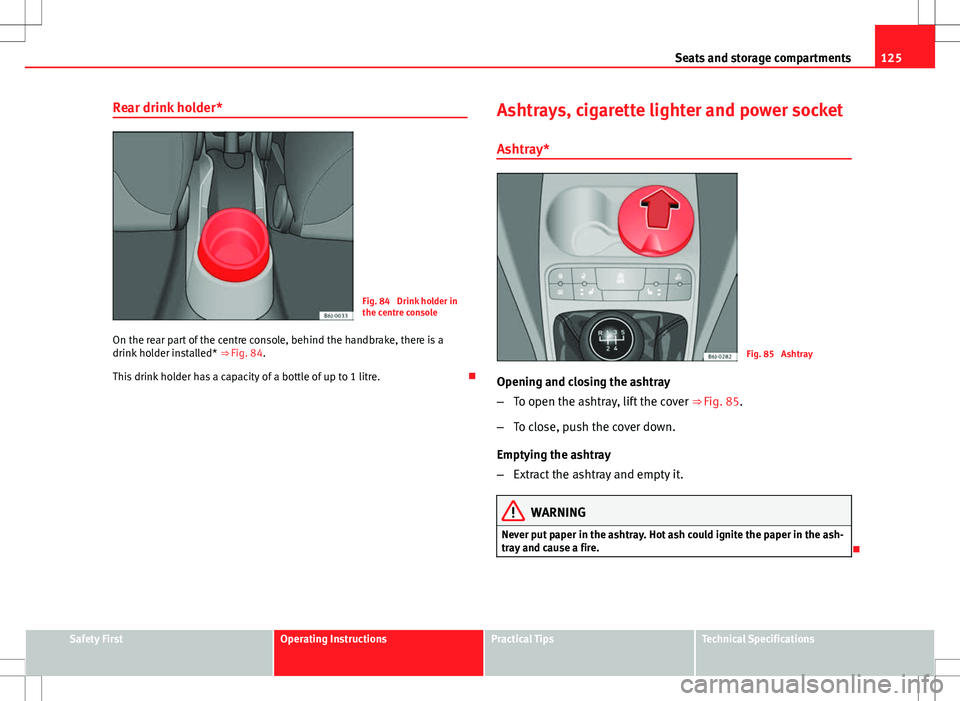
125
Seats and storage compartments
Rear drink holder*
Fig. 84 Drink holder in
the centre console
On the rear part of the centre console, behind the handbrake, there is a
drink holder installed* ββFig. 84.
This drink holder has a capacity of a bottle of up to 1 litre. οAshtrays, cigarette lighter and power socket
Ashtray*
Fig. 85 Ashtray
Opening and closing the ashtray
β To open the ashtray, lift the cover ββFig. 85.
β To close, push the cover down.
Emptying the ashtray
β Extract the ashtray and empty it.
WARNING
Never put paper in the ashtray. Hot ash could ignite the paper in the ash-
tray and cause a fire.
ο
Safety FirstOperating InstructionsPractical TipsTechnical Specifications
Page 128 of 282
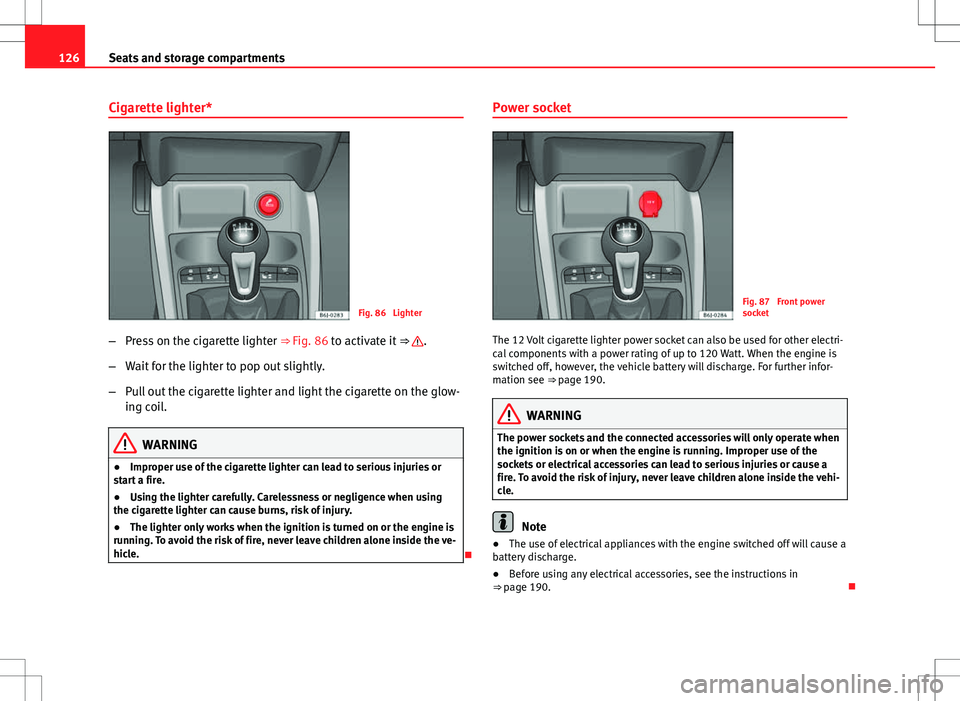
126Seats and storage compartments
Cigarette lighter*
Fig. 86 Lighter
β Press on the cigarette lighter ββFig. 86 to activate it ββ
.
β Wait for the lighter to pop out slightly.
β Pull out the cigarette lighter and light the cigarette on the glow-
ing coil.
WARNING
β Improper use of the cigarette lighter can lead to serious injuries or
start a fire.
β Using the lighter carefully. Carelessness or negligence when using
the cigarette lighter can cause burns, risk of injury.
β The lighter only works when the ignition is turned on or the engine is
running. To avoid the risk of fire, never leave children alone inside the ve-
hicle.
ο Power socket
Fig. 87 Front power
socket
The 12 Volt cigarette lighter power socket can also be used for other electri-
cal components with a power rating of up to 120 Watt. When the engine is
switched off, however, the vehicle battery will discharge. For further infor-
mation see ββpage 190.
WARNING
The power sockets and the connected accessories will only operate when
the ignition is on or when the engine is running. Improper use of the
sockets or electrical accessories can lead to serious injuries or cause a
fire. To avoid the risk of injury, never leave children alone inside the vehi-
cle.
Note
β The use of electrical appliances with the engine switched off will cause a
battery discharge.
β Before using any electrical accessories, see the instructions in
ββpage 190. ο
Page 132 of 282
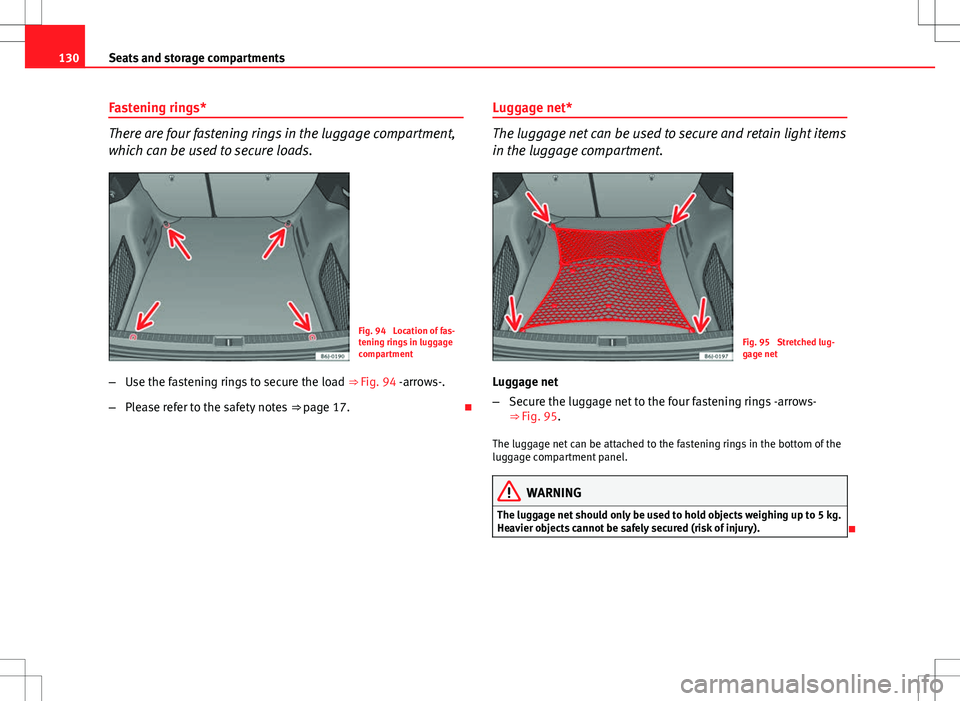
130Seats and storage compartments
Fastening rings*
There are four fastening rings in the luggage compartment,
which can be used to secure loads.
Fig. 94 Location of fas-
tening rings in luggage
compartment
β Use the fastening rings to secure the load ββFig. 94 -arrows-.
β Please refer to the safety notes ββpage 17. οLuggage net*
The luggage net can be used to secure and retain light items
in the luggage compartment.
Fig. 95 Stretched lug-
gage net
Luggage net
β Secure the luggage net to the four fastening rings -arrows-
ββFig. 95.
The luggage net can be attached to the fastening rings in the bottom of the
luggage compartment panel.
WARNING
The luggage net should only be used to hold objects weighing up to 5 kg.
Heavier objects cannot be safely secured (risk of injury).
ο
Page 134 of 282
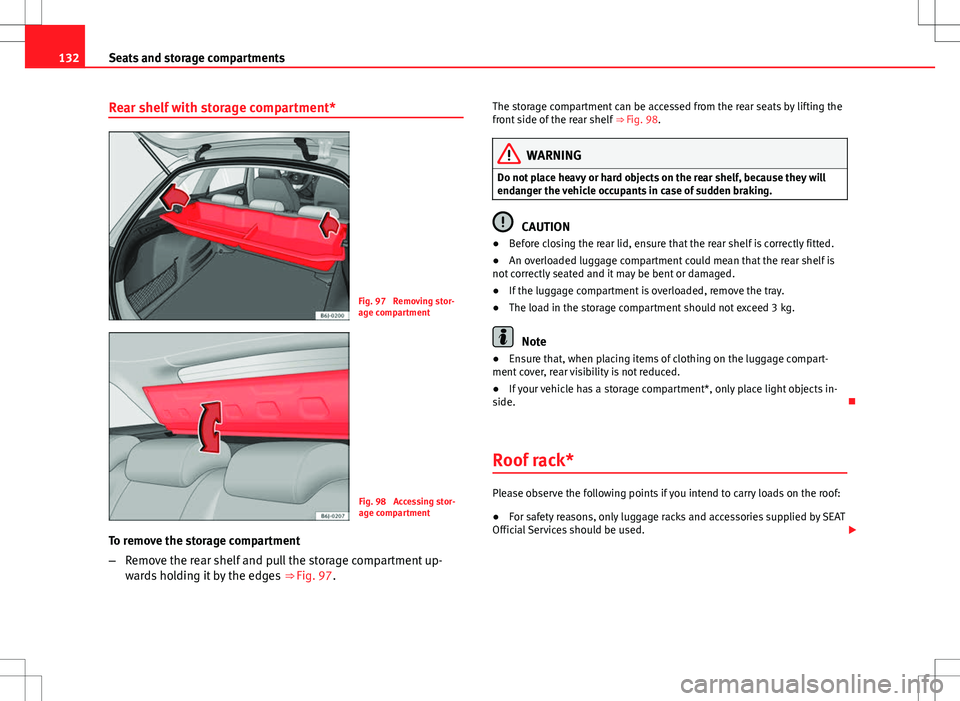
132Seats and storage compartments
Rear shelf with storage compartment*
Fig. 97 Removing stor-
age compartment
Fig. 98 Accessing stor-
age compartment
To remove the storage compartment
β Remove the rear shelf and pull the storage compartment up-
wards holding it by the edges ββFig. 97. The storage compartment can be accessed from the rear seats by lifting the
front side of the rear shelf
ββFig. 98.
WARNING
Do not place heavy or hard objects on the rear shelf, because they will
endanger the vehicle occupants in case of sudden braking.
CAUTION
β Before closing the rear lid, ensure that the rear shelf is correctly fitted.
β An overloaded luggage compartment could mean that the rear shelf is
not correctly seated and it may be bent or damaged.
β If the luggage compartment is overloaded, remove the tray.
β The load in the storage compartment should not exceed 3 kg.
Note
β Ensure that, when placing items of clothing on the luggage compart-
ment cover, rear visibility is not reduced.
β If your vehicle has a storage compartment*, only place light objects in-
side. ο
Roof rack*
Please observe the following points if you intend to carry loads on the roof:
β For safety reasons, only luggage racks and accessories supplied by SEAT
Official Services should be used. ο£
Page 136 of 282
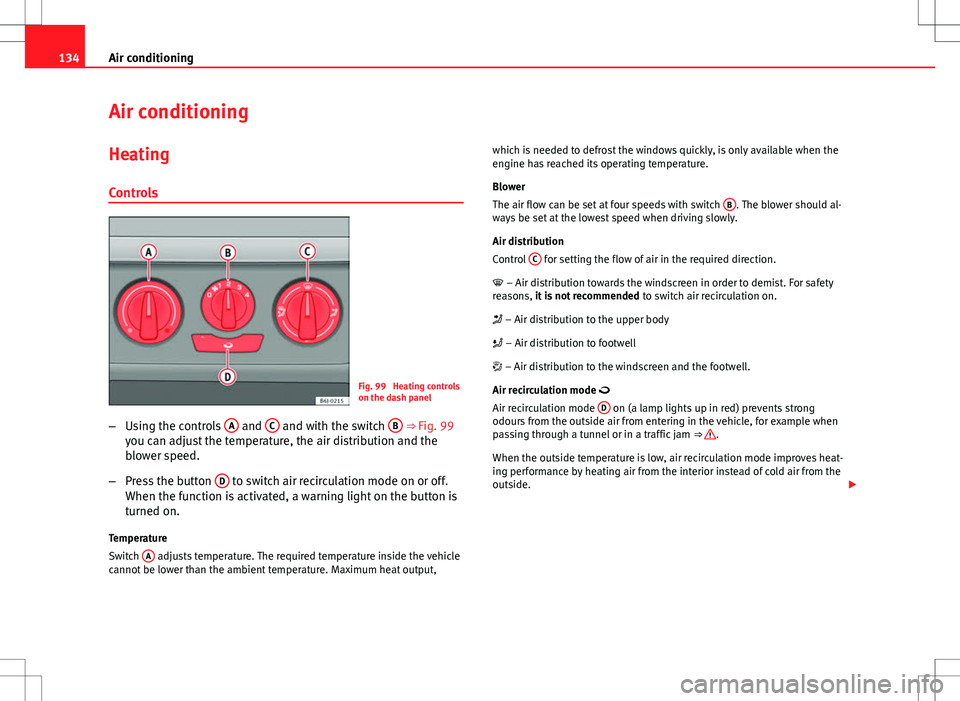
134Air conditioning
Air conditioning
Heating
Controls
Fig. 99 Heating controls
on the dash panel
β Using the controls A
and C and with the switch B ββFig. 99
you can adjust the temperature, the air distribution and the
blower speed.
β Press the button D
to switch air recirculation mode on or off.
When the function is activated, a warning light on the button is
turned on.
Temperature
Switch A
adjusts temperature. The required temperature inside the vehicle
cannot be lower than the ambient temperature. Maximum heat output, which is needed to defrost the windows quickly, is only available when the
engine has reached its operating temperature.
Blower
The air flow can be set at four speeds with switch
B
. The blower should al-
ways be set at the lowest speed when driving slowly.
Air distribution
Control C
for setting the flow of air in the required direction.
ο β Air distribution towards the windscreen in order to demist. For safety
reasons, it is not recommended to switch air recirculation on.
ο± β Air distribution to the upper body
ο² β Air distribution to footwell
ο« β Air distribution to the windscreen and the footwell.
Air recirculation mode ο
Air recirculation mode D
on (a lamp lights up in red) prevents strong
odours from the outside air from entering in the vehicle, for example when
passing through a tunnel or in a traffic jam ββ
.
When the outside temperature is low, air recirculation mode improves heat-
ing performance by heating air from the interior instead of cold air from the
outside. ο£
Page 139 of 282
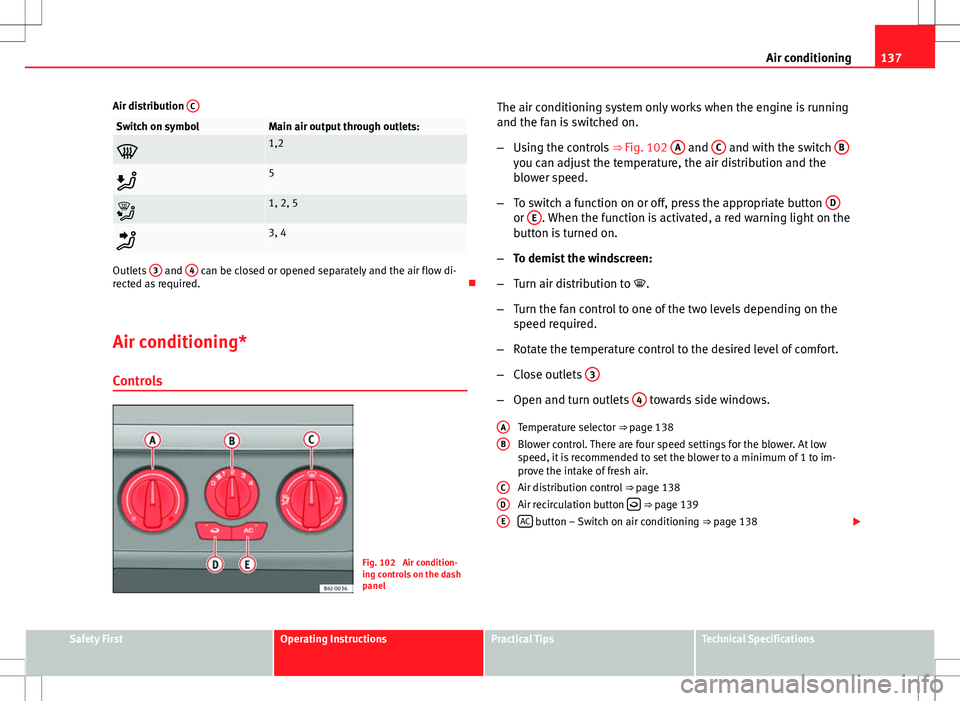
137
Air conditioning
Air distribution C
Switch on symbolMain air output through outlets:
ο1,2
ο²5
οΆ1, 2, 5
ο±3, 4
Outlets 3 and 4 can be closed or opened separately and the air flow di-
rected as required. ο
Air conditioning* Controls
Fig. 102 Air condition-
ing controls on the dash
panel The air conditioning system only works when the engine is running
and the fan is switched on.
β
Using the controls ββFig. 102 A
and C and with the switch Byou can adjust the temperature, the air distribution and the
blower speed.
β To switch a function on or off, press the appropriate button D
or E. When the function is activated, a red warning light on the
button is turned on.
β To demist the windscreen:
β Turn air distribution to ο.
β Turn the fan control to one of the two levels depending on the
speed required.
β Rotate the temperature control to the desired level of comfort.
β Close outlets 3
β
Open and turn outlets 4 towards side windows.
Temperature selector ββpage 138
Blower control. There are four speed settings for the blower. At low
speed, it is recommended to set the blower to a minimum of 1 to im-
prove the intake of fresh air.
Air distribution control ββpage 138
Air recirculation button ο
ββpage 139
AC button β Switch on air conditioning ββpage 138ο£
A
B
CDE
Safety FirstOperating InstructionsPractical TipsTechnical Specifications
Page 140 of 282
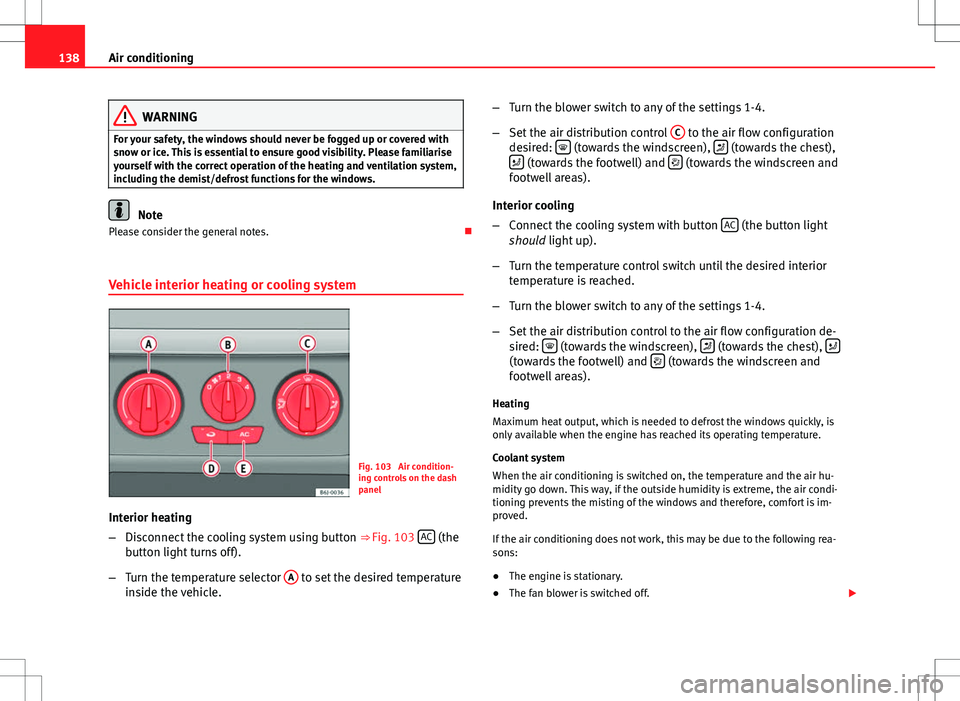
138Air conditioning
WARNING
For your safety, the windows should never be fogged up or covered with
snow or ice. This is essential to ensure good visibility. Please familiarise
yourself with the correct operation of the heating and ventilation system,
including the demist/defrost functions for the windows.
Note
Please consider the general notes. ο
Vehicle interior heating or cooling system
Fig. 103 Air condition-
ing controls on the dash
panel
Interior heating
β Disconnect the cooling system using button ββFig. 103 AC
(the
button light turns off).
β Turn the temperature selector A
to set the desired temperature
inside the vehicle. β
Turn the blower switch to any of the settings 1-4.
β Set the air distribution control C
to the air flow configuration
desired: ο (towards the windscreen), ο± (towards the chest),
ο² (towards the footwell) and ο« (towards the windscreen and
footwell areas).
Interior cooling
β Connect the cooling system with button AC
(the button light
should light up).
β Turn the temperature control switch until the desired interior
temperature is reached.
β Turn the blower switch to any of the settings 1-4.
β Set the air distribution control to the air flow configuration de-
sired: ο
(towards the windscreen), ο± (towards the chest), ο²(towards the footwell) and ο« (towards the windscreen and
footwell areas).
Heating
Maximum heat output, which is needed to defrost the windows quickly, is
only available when the engine has reached its operating temperature.
Coolant system
When the air conditioning is switched on, the temperature and the air hu-
midity go down. This way, if the outside humidity is extreme, the air condi-
tioning prevents the misting of the windows and therefore, comfort is im-
proved.
If the air conditioning does not work, this may be due to the following rea-
sons:
β The engine is stationary.
β The fan blower is switched off. ο£
Page 141 of 282
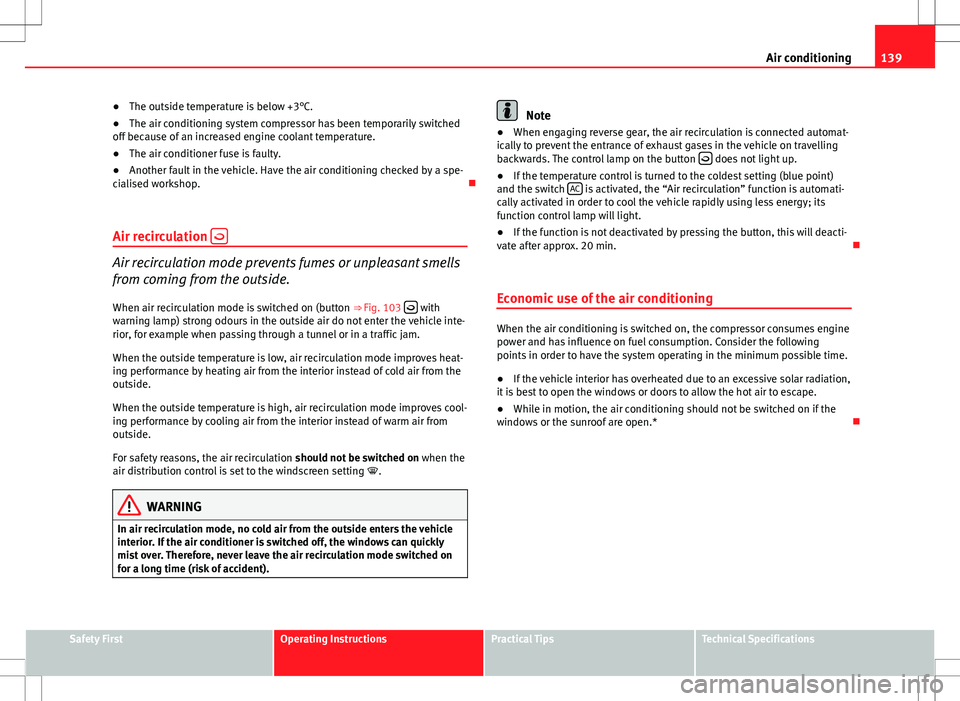
139
Air conditioning
β The outside temperature is below +3Β°C.
β The air conditioning system compressor has been temporarily switched
off because of an increased engine coolant temperature.
β The air conditioner fuse is faulty.
β Another fault in the vehicle. Have the air conditioning checked by a spe-
cialised workshop. ο
Air recirculation ο
Air recirculation mode prevents fumes or unpleasant smells
from coming from the outside.
When air recirculation mode is switched on (button ββFig. 103 ο
with
warning lamp) strong odours in the outside air do not enter the vehicle inte-
rior, for example when passing through a tunnel or in a traffic jam.
When the outside temperature is low, air recirculation mode improves heat-
ing performance by heating air from the interior instead of cold air from the
outside.
When the outside temperature is high, air recirculation mode improves cool-
ing performance by cooling air from the interior instead of warm air from
outside.
For safety reasons, the air recirculation should not be switched on when the
air distribution control is set to the windscreen setting ο.
WARNING
In air recirculation mode, no cold air from the outside enters the vehicle
interior. If the air conditioner is switched off, the windows can quickly
mist over. Therefore, never leave the air recirculation mode switched on
for a long time (risk of accident).
Note
β When engaging reverse gear, the air recirculation is connected automat-
ically to prevent the entrance of exhaust gases in the vehicle on travelling
backwards. The control lamp on the button ο
does not light up.
β If the temperature control is turned to the coldest setting (blue point)
and the switch AC
is activated, the βAir recirculationβ function is automati-
cally activated in order to cool the vehicle rapidly using less energy; its
function control lamp will light.
β If the function is not deactivated by pressing the button, this will deacti-
vate after approx. 20 min. ο
Economic use of the air conditioning
When the air conditioning is switched on, the compressor consumes engine
power and has influence on fuel consumption. Consider the following
points in order to have the system operating in the minimum possible time.
β If the vehicle interior has overheated due to an excessive solar radiation,
it is best to open the windows or doors to allow the hot air to escape.
β While in motion, the air conditioning should not be switched on if the
windows or the sunroof are open.* ο
Safety FirstOperating InstructionsPractical TipsTechnical Specifications
Page 143 of 282
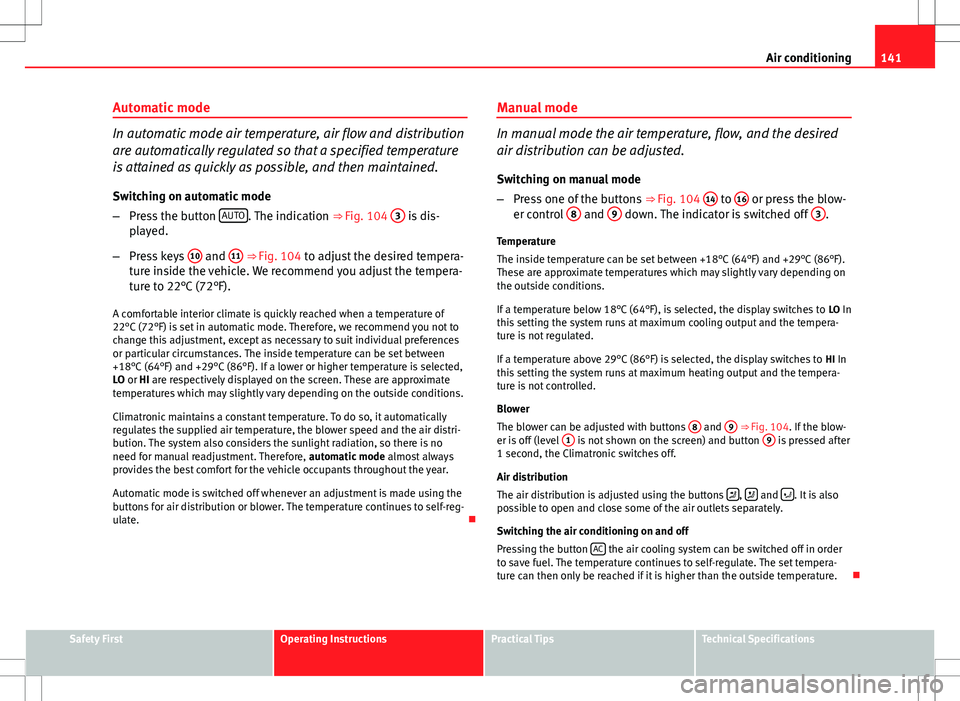
141
Air conditioning
Automatic mode
In automatic mode air temperature, air flow and distribution
are automatically regulated so that a specified temperature
is attained as quickly as possible, and then maintained. Switching on automatic mode
β Press the button AUTO
. The indication
ββFig. 104 3 is dis-
played.
β Press keys 10
and 11 ββFig. 104 to adjust the desired tempera-
ture inside the vehicle. We recommend you adjust the tempera-
ture to 22Β°C (72Β°F).
A comfortable interior climate is quickly reached when a temperature of
22Β°C (72Β°F) is set in automatic mode. Therefore, we recommend you not to
change this adjustment, except as necessary to suit individual preferences
or particular circumstances. The inside temperature can be set between
+18Β°C (64Β°F) and +29Β°C (86Β°F). If a lower or higher temperature is selected,
LO or HI are respectively displayed on the screen. These are approximate
temperatures which may slightly vary depending on the outside conditions.
Climatronic maintains a constant temperature. To do so, it automatically
regulates the supplied air temperature, the blower speed and the air distri-
bution. The system also considers the sunlight radiation, so there is no
need for manual readjustment. Therefore, automatic mode almost always
provides the best comfort for the vehicle occupants throughout the year.
Automatic mode is switched off whenever an adjustment is made using the
buttons for air distribution or blower. The temperature continues to self-reg-
ulate. οManual mode
In manual mode the air temperature, flow, and the desired
air distribution can be adjusted.
Switching on manual mode
β Press one of the buttons ββFig. 104 14
to 16 or press the blow-
er control 8 and 9 down. The indicator is switched off 3.
Temperature
The inside temperature can be set between +18Β°C (64Β°F) and +29Β°C (86Β°F).
These are approximate temperatures which may slightly vary depending on
the outside conditions.
If a temperature below 18Β°C (64Β°F), is selected, the display switches to LO In
this setting the system runs at maximum cooling output and the tempera-
ture is not regulated.
If a temperature above 29Β°C (86Β°F) is selected, the display switches to HI In
this setting the system runs at maximum heating output and the tempera-
ture is not controlled.
Blower
The blower can be adjusted with buttons 8
and 9 ββFig. 104. If the blow-
er is off (level 1 is not shown on the screen) and button 9 is pressed after
1 second, the Climatronic switches off.
Air distribution
The air distribution is adjusted using the buttons ο±
, οΆ and οͺ. It is also
possible to open and close some of the air outlets separately.
Switching the air conditioning on and off
Pressing the button AC
the air cooling system can be switched off in order
to save fuel. The temperature continues to self-regulate. The set tempera-
ture can then only be reached if it is higher than the outside temperature. ο
Safety FirstOperating InstructionsPractical TipsTechnical Specifications